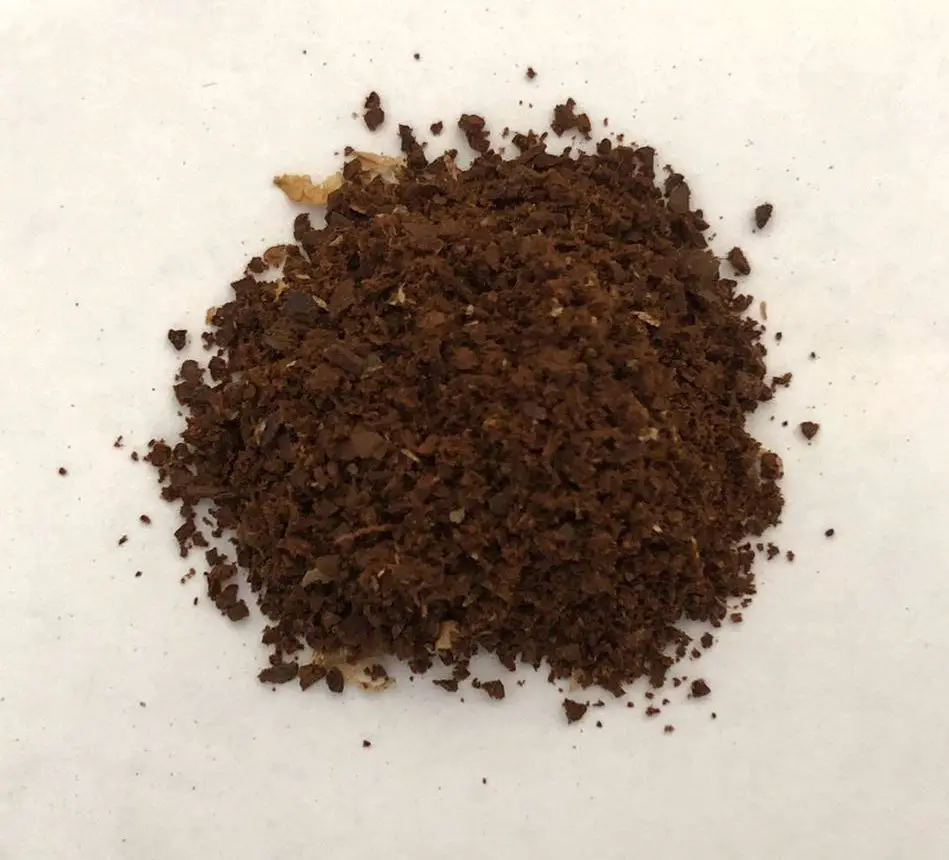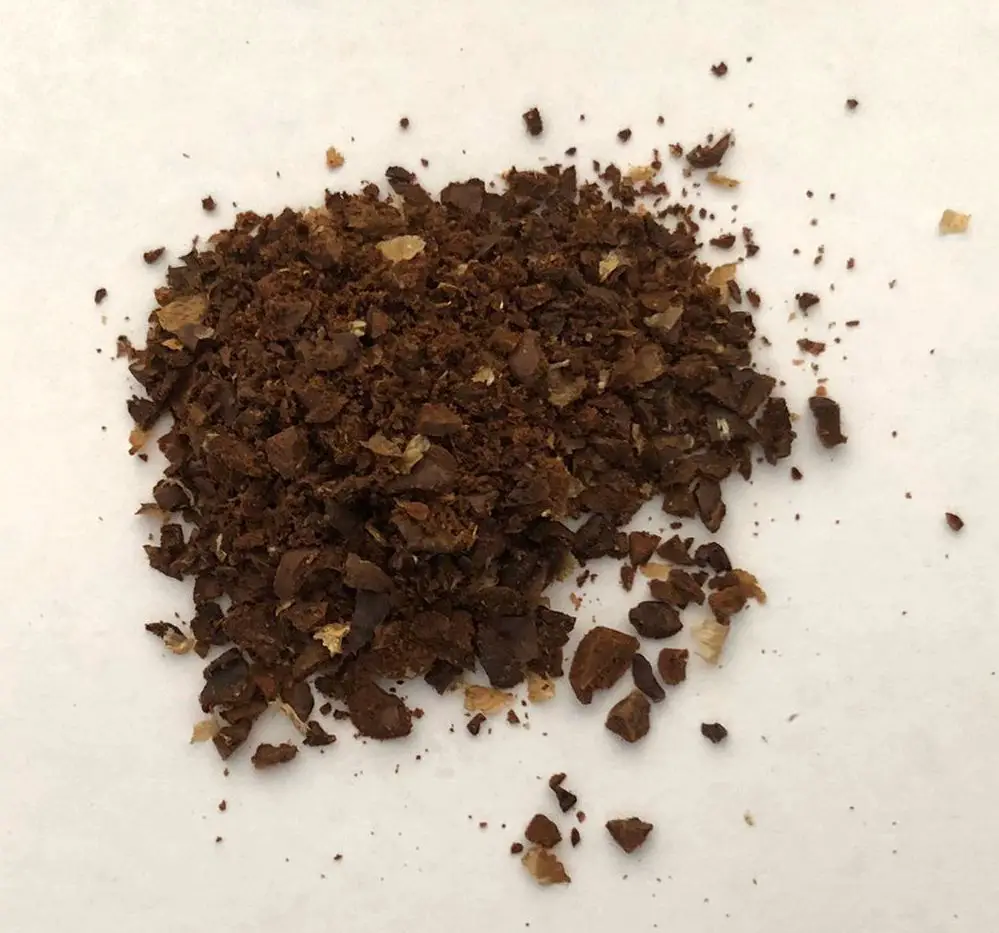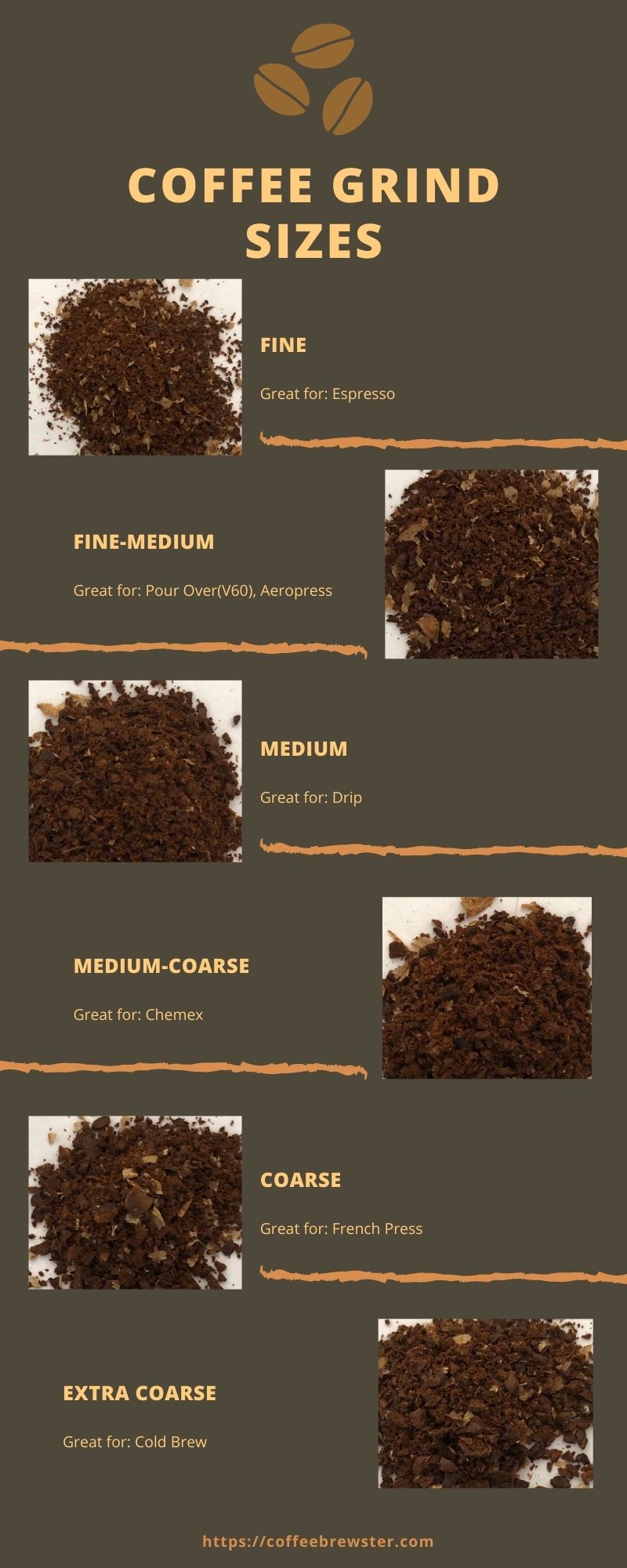Making a great cup of coffee relies on two critical factors: the type of coffee beans you use and the way you grind them.
If you mess up the grind size, your coffee will turn out very strange. Dialing in the grind size is a key skill you need to hone in on your journey to become a coffee geek yourself, and this coffee grind size chart is just the place to start.
We’ve got you covered 🙂
Fortunately, coffee grinding is not rocket science. However, there are a few things you need to understand, all of which we’ll cover in depth.
Coffee Grind Size Chart and Guide:
Coffee grind sizes range from extra fine all the way to extra coarse. It’s important to understand each grind size first, then apply it to a brewing method.
This is because one brewing method may call for one or two different grind sizes, depending on the results you are trying to achieve.
| Grind size | Brewing method |
| Extra-Fine | Turkish |
| Fine | Espresso |
| Fine-Medium | Pour Over, Aeropress, Moka pot |
| Medium | Drip, Siphon |
| Medium-Coarse | Chemex, Osmotic Flow |
| Coarse | French Press |
| Super-Coarse | Cold Brew |
Extra-Fine Grind
Coffee ground to an extra fine consistency is extremely soft, almost like flour. Not all grinders can go to such a fine consistency, so if you’re looking to drink a lot of Turkish coffee, get a grinder that can manage it!
Works best with:
Turkish coffee
Fine Grind(Espresso Grind)

Finely ground coffee is just a touch above extra-fine, like the consistency of table salt. Most grinders will manage a fine grind as their first setting. On a manual grinder, this is usually one click above completely shut.
Works best with:
- Espresso
Fine-Medium Grind(Pour Over Grind and Aeropress grind)

Fine-medium ground is one touch above fine ground, somewhere between the consistency of table salt and sand. Go one or two clicks above fine grind to achieve fine-medium.
Works best with:
Medium Grind (Drip Coffee Grind)

Medium grind coffee is the consistency of sand. You can easily feel the grains in between your fingers. This is usually the halfway setting. So if your grinder goes from 0 to 15, medium grind would be around 8.
Works best with:
- Drip coffee makers
- Siphon coffee makers
- AeroPress brews with extended brew times
Medium-Coarse Grind (Chemex Grind)

Medium coarse grind is a couple of clicks above medium grind. You can now easily see the grind particles and distinguish between each grind particle in between your fingers.
Works best with:
- Chemex
- Slightly stronger french press
- Osmotic Flow
Coarse Grind (french press grind)

Coarse is almost the last setting on your grinder – just a few clicks below. An ideal grind for french press looks much like flaky sea salt. Each particle can easily be distinguished by eye.
Works best with:
- French press
- Coffee cupping
Super-Coarse Grind (cold brew grind)

The biggest grind size you’ll need is super-coarse, which would be the very last setting on your grinder. This grind size looks a lot like very coarsely crushed peppercorns.
Works best with:
- Cold brew
Coffee Grinding Guide
Now that we’ve covered the basics of the different types of coffee grinds, it’s time to talk about why grinding is really important and how to properly grind your coffee beans.
Why is coffee grind size so important?
As much as the coffee beans that you use are important, so is the coffee grind size. If you did not use the correct grind size, even the most advanced coffee machine in the world will not be able to make you a good cup of coffee.
On the flip side, freshly ground coffee just thrown in boiling water will produce a better cup than poorly ground or stale coffee in an expensive machine!
The coffee grind size controls the speed of extraction.
It’s basic science: a finer grind results in a larger surface area, so the extraction will be much faster.
A slower grind results in a smaller surface area, meaning the extraction will be slower.
Looking at two extremes, espresso requires a fine grind, because the brew time is really short! In the short 20-30 seconds that it takes to brew, a lot of flavors must be extracted from the coffee grounds.
The other end of the spectrum is cold brew, which requires a very coarse grind. Cold brew is a slow, steady steep, so you want the grinds to be as coarse as possible to allow for a slow and even extraction.
Related: Read our buyer’s guide for the best coffee beans
What happens if coffee is under or over extracted?
By not aligning the grind size with the type of brew you’re after, you’re risking extracting your coffee too less or too little.
Both result in undesirable flavors in your coffee:
| Under-extracted coffee | Over-extracted coffee |
| Sour and acidic | Bitter |
| Salty | No flavor notes |
While we’re on the topic, it’s worth mentioning that under-and-over extraction can also happen if you don’t brew for long enough.
A typical french press brew should be four minutes. If you plunge in two minutes and taste it, it will taste under-extracted.
On the other hand, if you grind too fine and brew for four minutes, you’ll end up with over-extracted coffee!
A typical pour over brew lasts between one and a half to three minutes. If you grind too coarse, the water will flow through too quickly and you’ll end up with an under-extracted cup.
The opposite will happen if you grind too fine.
Should you use a burr grinder or a blade grinder?
For good coffee, you must use a burr grinder!
There’s no way around it.
A blade grinder does not grind evenly, and you’ll end up with a mess on your hands. Burr grinders let you lock the distance between the two burrs, meaning the coffee grounds will turn out very consistent.
Consistency is key!
Blade grinders have no way to control the consistency, so all you can do is estimate. This usually results in some grinds being fine and others being coarse.
This kind of inconsistency is passable for french press, but disastrous for espresso and pour over.
How to grind and dial in your coffee
The first step is to get a decent grinder! Electric burr grinders have a dial you can use to control the grind size.
Manual grinders usually have a set screw below the top chamber that you can use to adjust the grind size.
Extremely cheap grinders do have a set screw but don’t have any feedback system, so you don’t know how fine or coarse you’ve gone until you actually grind the coffee and observe.
Your grinder usually comes with an instruction manual that has suggested ranges for various brews.
Stick to the suggested ranges to start, and using the principles of over and under extraction that we saw above, adjust your grind up and down one to two clicks at a time until you get to a desirable flavor.
For example, if your grinder can be adjusted to 15 clicks from 1 to 15, 1-2 would be espresso, 3-5 would be pour over, 6-9 would be drip, 10-12 would be Chemex, 13-14 would be french press, and 15 would be cold brew.
You can begin to see why having a grinder with more adjustment steps comes in handy!
When you adjust the grind, remember to keep all other variables the same! That means the type of coffee, the brew method, the brew time, and the water temperature should not be any different.
Conclusion
Now that you’re a coffee grinding pro, it’s time to experiment and see what kinds of grind sizes work best for you.
The grind sizes provided here are benchmarks and you should not stray too far away from them. However, it’s your cup of coffee, and you can adjust the brewing parameters up or down to get a resulting cup that is to your liking.
That’s the power of grinding fresh coffee beans: you are in total control of your brew!
What’s the best grind for drip coffee?
The best grind for drip coffee is a medium grind or regular grind. This will be just around the halfway point in your grinder’s settings. You can refer to the images above for more clarity.
Drip coffee is very forgiving, so you can even go a little finer or a little coarser and still get good tasting coffee.
What’s the right grind size for Aeropress?
Aeropress is an incredibly versatile brewer and you can actually make it work with everything from a fine-medium to a coarse grind, depending on how long you brew.
The classic Aeropress recipe as recommended by the manufacturer uses a fine-medium grind similar to pour over. There are other methods like inverted Aeropress and James Hoffman’s Aeropress recipe that use slightly coarser grinds.
What’s the best grind size for Moka pot?
The best grind size for Moka pot is fine-medium. You want to have the grounds fine enough to extract strong flavors from the coffee, but not too fine as to prevent the steam from rising!
What’s the best grind size for espresso?
Espresso requires a very fine grind that’s similar to table salt. It should feel very powdery in your hands, but not as soft as flour.
What’s the best grind size for Chemex?
Even though the Chemex is a pour-over brewer, it does best with a slightly coarser grind size than other pour-overs like the Hario V60.
This is because the Chemex filter is incredibly thick, so water will flow very slowly. If your grinds are too fine, the coffee will be over-extracted. To counter this, you can use a slightly coarser grind and get the same result.
How often should I grind coffee?
Every day, just before you brew! The best coffee is made by grinding just before brewing and only grinding as much as you need.


